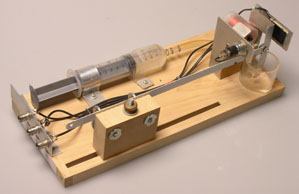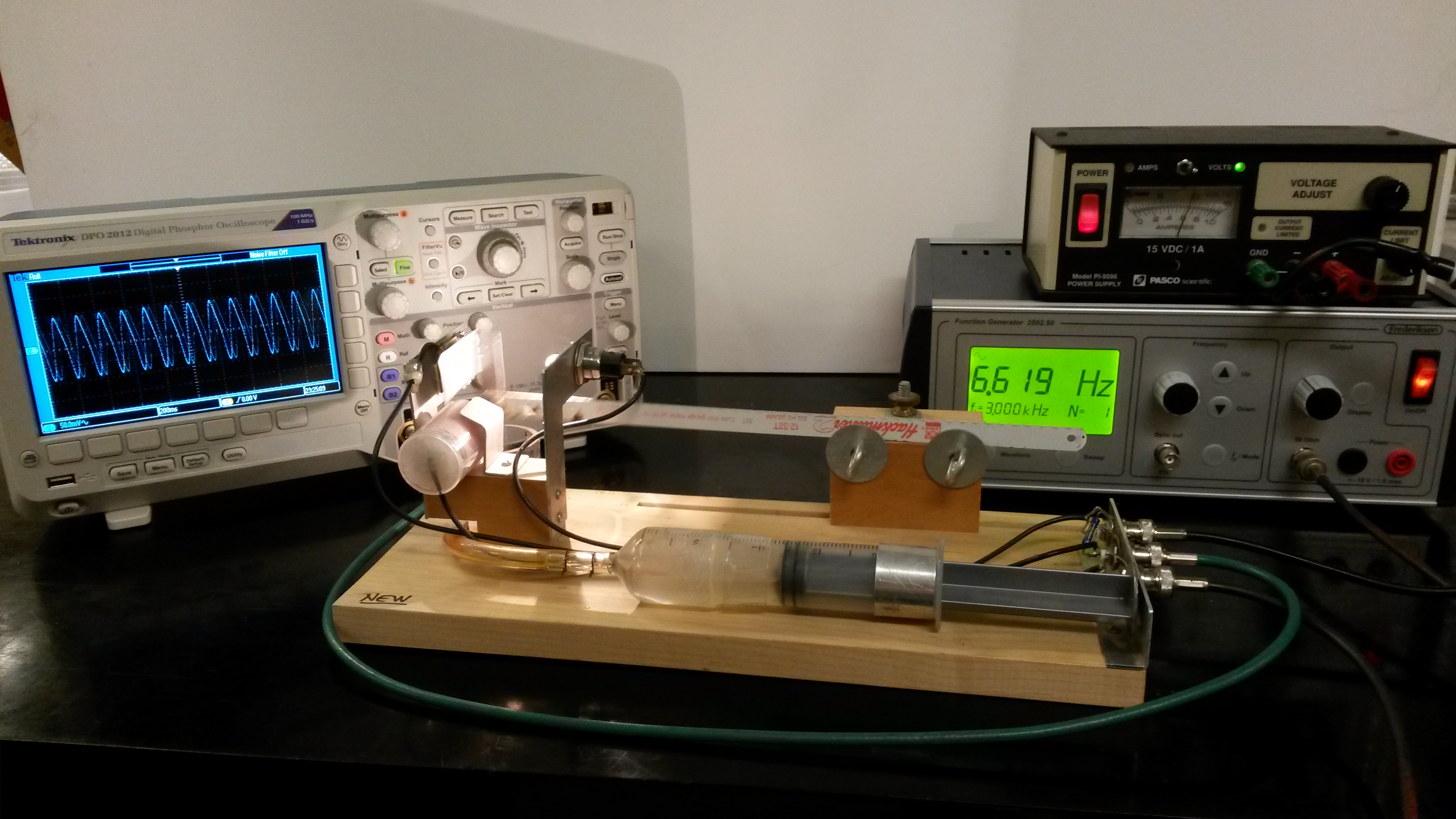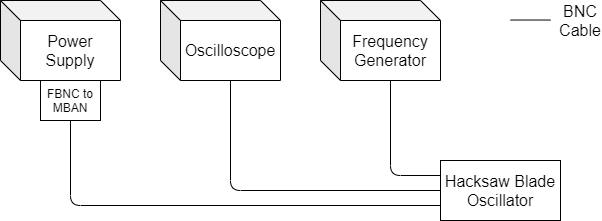This apparatus demonstrates forced and damped harmonic motion.
List of parts:
- Hacksaw blade apparatus
- DC power supply (6V)
- Function generator (sine mode)
- Oscilloscope
- Female BNC to male banana converter
- 3x BNC cable
- Video camera (recommended for large classes)

Figure 2 – Hacksaw blade oscillator apparatus
Procedure:
- Connect oscilloscope, DC power supply, and functional generator as shown in Fig. 3.
- Make sure that the metal plate at the end of the blade covers half of the photocell when the blade is in the neutral position.
- Set function generator at the resonant frequency (about 6.6 Hz) and to 3-6V. At resonance, the signal should fill the screen vertically.
- Set the power supply to about 6V and make sure there is no other direct light on the photocell.
- Use the syringe to empty or fill glycerin reservoir to receive desired amount of damping.
- Adjust the function generator to compensate for the new resonant frequency with the glycerin added (when filled with glycerin the resonant frequency is about 6.0 Hz).
Oscillators:
Simple Harmonic Oscillator
A Harmonic Oscillator is a system in which a mass, in this case the tip of the hacksaw blade, oscillates around a center point at its fundamental frequency. As the tip of the blade deviates from this center point, a restoring force driven by the elasticity of the blade pulls the tip of the blade back to the center. Oscillating around the center point, the position of the tip of the blade is represented by a sine wave. This restoring force is a function of the displacement from the center and a constant of the blade.
Where F is the restoring force, k is the spring constant of the blade, and x is the displacement from the center.
Damped Harmonic Oscillator
A damped harmonic oscillator is a system much like a simple harmonic oscillator but with an external force, usually friction, resisting the movement of the system. In this case, the movement of the tip of the blade is damped by both air friction and the viscosity of the fluid in the beaker. While the friction due to air is mostly negligible, the glycerin adds a considerable damping force.
The force equation for a damped harmonic oscillator is shown below
Where c is the viscous damping coefficient
Driven Harmonic Oscillator
A driven harmonic oscillator acts much like a simple harmonic oscillator but with an additional external force adding to the blade movement. In this system, the amplitude of the oscillating blade is constantly increasing until the interference between the driving force and the spring constant force cancel one another out.
The force equation for driven harmonic oscillator is shown below.
Where F(t) is the driving force at a time t.
Damped Driven Harmonic Oscillator
A damped driven harmonic oscillator acts much like a damped harmonic oscillator, but with an external force adding energy to the system instead of removing it via resistive forces like the viscosity of the fluid in the beaker. By adjusting the induced force on the blade and the amount of fluid resisting the blade tip movement, a resonant frequency can be induced in the blade.
The force equation for a damped driven harmonic oscillator is shown below
Demo:
This demonstration can show either a damped harmonic oscillator or a damped driven harmonic oscillator. Without the function generator attached to the solenoid, the hacksaw blade oscillator acts as a damped oscillator. By initiating a movement in the blade by hand, the oscilloscope shows a wave that decreases in amplitude over time while keeping a constant frequency. With the function generator on and set to its resonant frequency, the device becomes a damped driven harmonic oscillator. The solenoid drives the blade to pulse at the set frequency as the resistance from air and/or glycerin dampens the movement. As more glycerin is added and the system becomes more damped, the resonant frequency will decrease.
With no glycerin in the beaker, the resonant frequency of the hacksaw blade system is about 6.6 Hz. As the beaker is filled, the resonant frequency slowly decreases to about 6.0 Hz at the maximum amount of glycerin. With the damping glycerin, the amplitude of the blade decreases largely. This can be somewhat offset by increasing the voltage from the function generator.
Written by: Finn Amend

